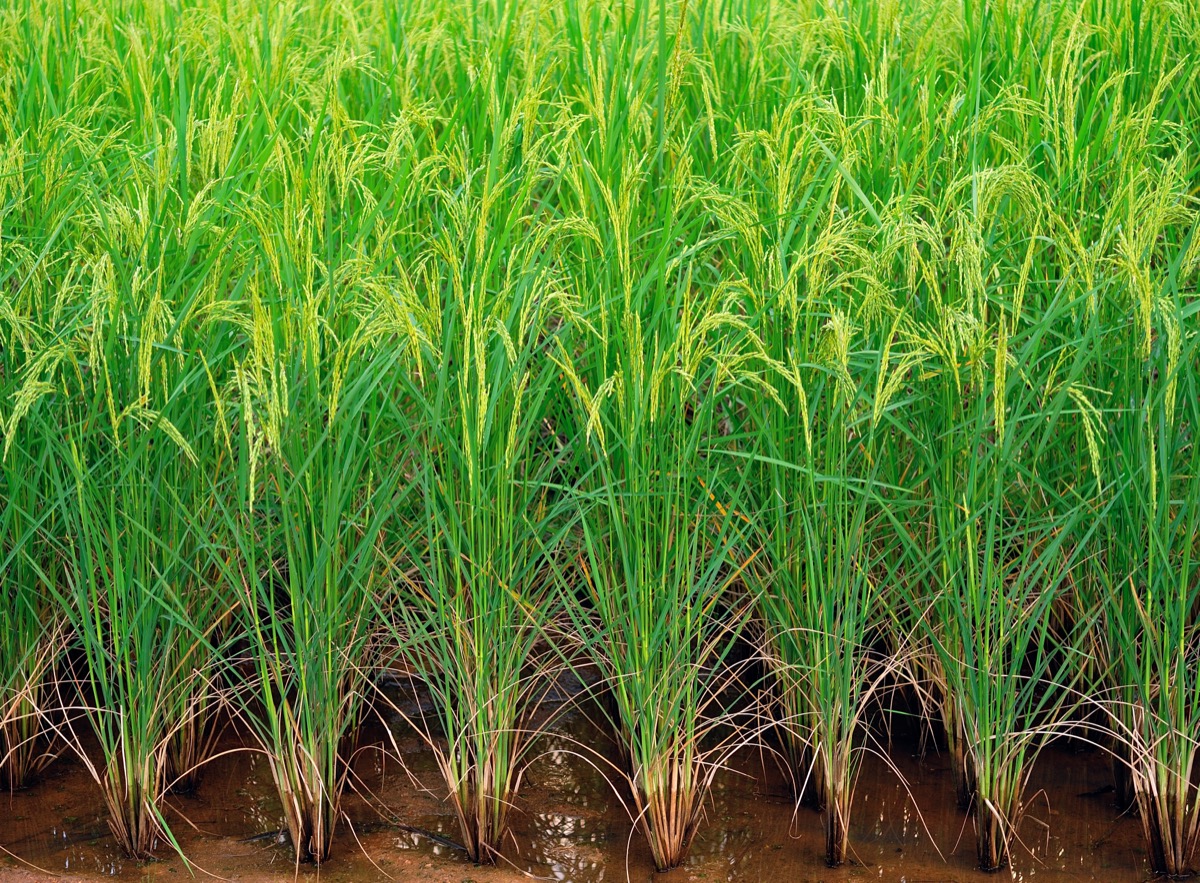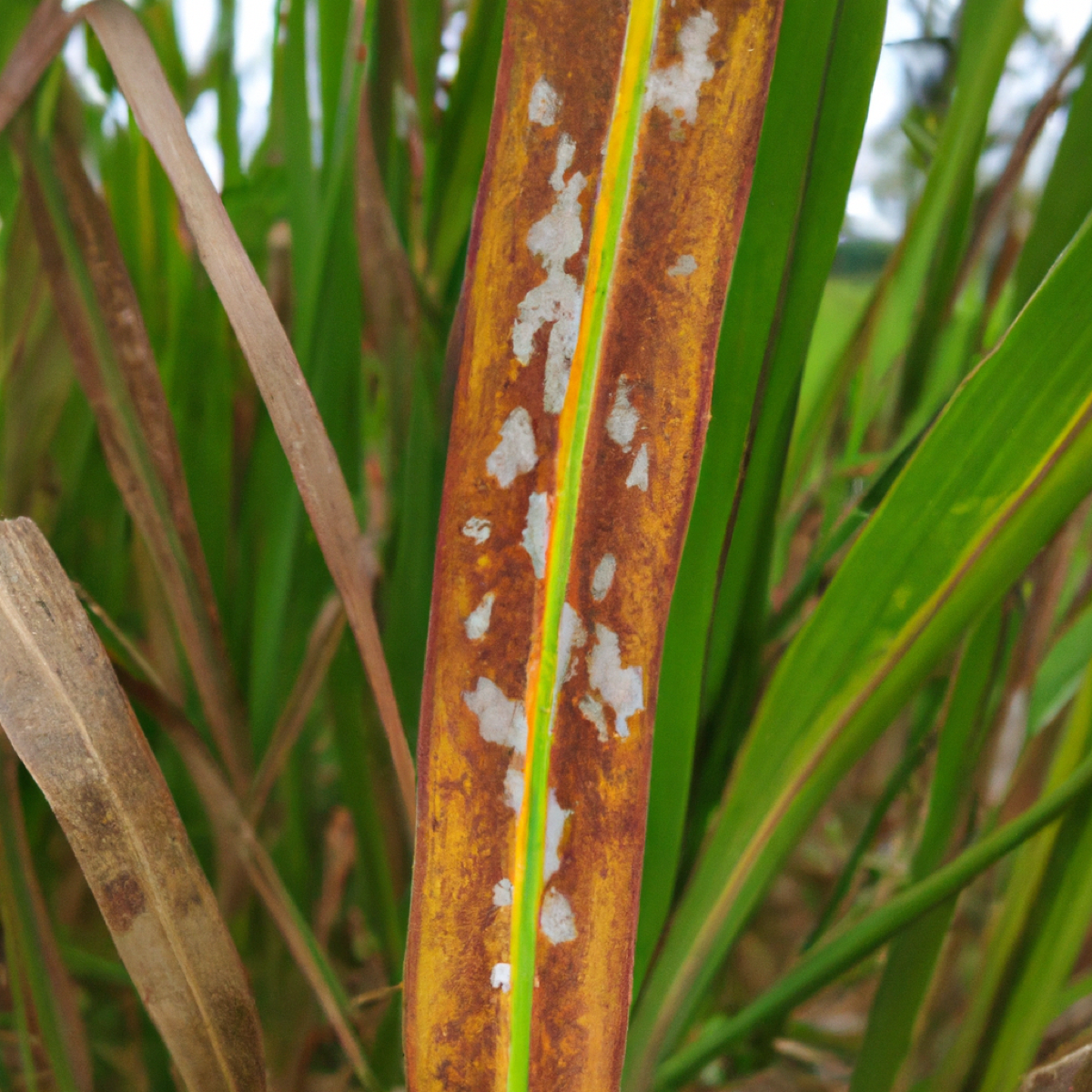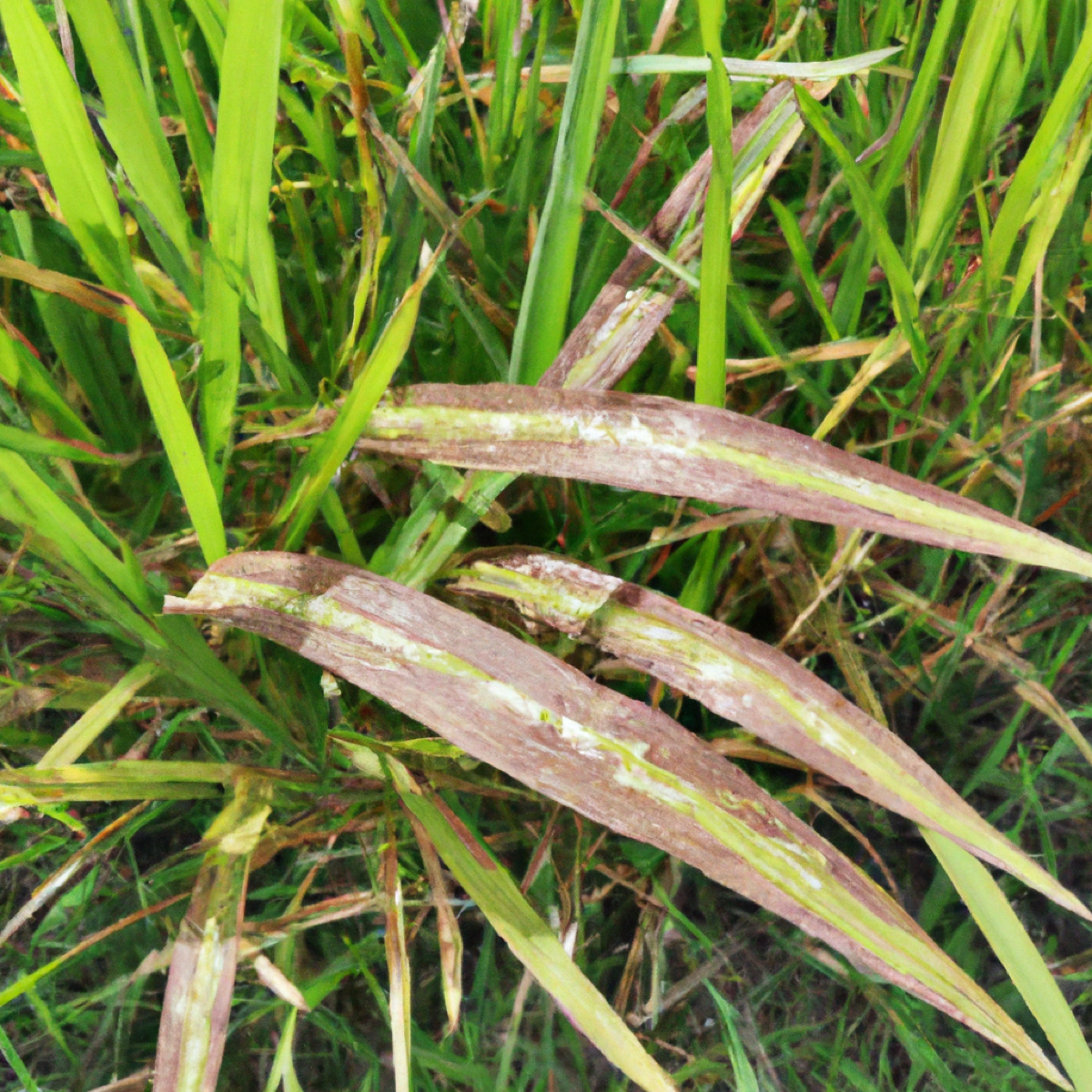Bacterial blight is a damaging pest that affects rice crops. It has yellowish stripes on the leaves, a wavy edge, and a milky dewdrop visible on the leaf surface in the early morning. Lesions develop yellow to white as the illness spreads, and highly diseased leaves dry fast. Bacterial leaf blight of paddy is caused by Xanthomonas oryzae pv. oryzae happens when the crop is in the stage between tillering and heading.

The native name for this disease is “Dundanu Macchhe Roga.” Yield loss can range from 6-60% in severe circumstances, and alternative hosts include grasses such as Leersia spp. and Cyperus rotundus.
Bacterial Leaf Blight management in Paddy
The causal organism of Bacterial Leaf Blight disease
Xanthomonas oryzae is the bacterium that causes bacterial blight in rice crops. It is a non-capsulated, gram-negative, rod-shaped bacteria that are aerobic, does not form spores, and measures 0.5–0.8 x 1-2 micrometres. It moves with a single polar flagellum, forming waxy yellow colonies on agar media. The optimal development temperature is 28–30°C, while the thermal death point is 53°C.
The Disease cycle of Bacterial Leaf Blight disease
- Bacterial leaf blight can be transmitted by seed and live for lengthy periods in seed or plant residue.
- Seed, rain and sprinkler watering, and damp weather are all conditions that help spread the disease.
- Bacteria emerge in the mid to high canopy and can spread throughout the plant, harming leaves, pods, and fruits.
- The disease appears early in the growing season while seedlings are forming.
- Once infected, the bacterium affects all phases of plant development and can cause premature defoliation.
- Defoliation exposes the plant’s fruit to direct sunlight, potentially resulting in significant production loss.
Mode of spread and survival of the pathogen in Paddy crop
The pathogen survives in soil and infected stubbles and on collateral hosts Leersia spp., Plantago najor, Paspalum dictum, and Cyanodon dactylon. The pathogen spreads via irrigation water as well as rainstorms.
Causes of Bacterial Leaf Blight Disease spread in the field
- Combinations of Humid weather above 70%, dull windy days.
- Very late top dressing and Flooding.
- Excessive rain and deep irrigation water
- Air temperature ranges from 22 to 26 degrees Celsius.
- N in high concentrations in the field.
- Planting nearby
Symptoms of Bacterial Leaf Blight disease
- Bacterial Blight Disease expresses itself in three ways: leaf blight, kresek, and pale-yellow leaf.
- The most noticeable and prevalent symptom is leaf blight. Circular yellow dots form on the leaves of seedlings and can cause the seedling to die.
- Water-soaked transparent lesions occur along the leaf margin in mature plants, expand, and become straw yellow. Lesions can cover the entire leaf, resulting in a white or straw-colored appearance.
- Bacterial milky dew droplets occur on new lesions and damage grains. When the cut end of a leaf is immersed in water, the water turns muddy owing to bacterial slime.
Percentage of yield loss due to Bacterial Leaf Blight Disease in Paddy crop
- The potential for a loss of 6–60% of the crop in a severe infection is the percentage of yield lost in paddy crops due to bacterial leaf blight disease.
- When plants are infected during the booting stage, bacterial blight has little effect on yield. Still, it causes poor grain quality and many damaged kernels.
Diagnosis of Bacterial Leaf Blight Disease in Paddy crop
Soaking seeds for 12 hours in a 0.025% agrimycin water solution and 0.05% wettable ceresan solution, followed by a 3-minute hot water treatment at 52°-54°C, will help suppress the first infection. Soak seeds in a 0.1% ceresan wet with streptomycin solution for 8 hours to test for the first infection.
In case you missed it: Mealybug Management in Paddy: Symptoms, Treatment, Chemical, Biological, Natural, and Organic Control

Cultural control measures of Bacterial Leaf Blight disease
- The stubbles should be burned.
- Use the right amount of fertilizer. When transplanting, avoid trimming the seedling’s tip.
- Avoid being in flooded areas.
- Weed hosts should be removed regularly.
- Only use disease-free seedlings.
- Make sure the field has a good drainage system.
- Allow two seasons for the soil to dry.
Biological control measures of Bacterial Leaf Blight disease
- Beneficial bacteria: Beneficial microbes such as Pseudomonas fluorescens can function as biocontrol agents against BLB by generating antibiotics that suppress X. oryzae growth.
- Intercropping: Intercropping paddy with non-host plants such as marigold, cowpea, or groundnut can help to keep BLB at bay.
Chemical control measures of Bacterial Leaf Blight disease
- To prevent the spread of this infection, soak the seeds for 20 minutes in a solution of 0.1 gm/liter streptocycline and 0.1 gm/liter copper sulfate.
- Spray Streptomycin sulfate and tetracycline combination 120g + Copper oxychloride 500 grams/ha.
- Seed treatment in one liter of water with 0.1 g Streptocycline and 0.1 g Copper Sulfate or 0.3 gram Agrimycin-100 and 0.1 gram Copper Oxychloride for 20 minutes
- Foliar spray of 0.05-gram Streptocycline and 0.05 g Copper Sulfate
- Although there are few chemical controls for Bacterial leaf blight, insecticides can be beneficial in decreasing bacteria spread. Because insects feed on sick plants and spread bacteria to non-affected plants, pesticides are a reasonable option. Before applying pesticides, check the label for precautionary warnings and application instructions.
Preventive measures for Control of Bacterial Leaf Blight disease
- Use of resistant varieties
- Balance fertilizer application: split application of nitrogen.
- Reduce disease transmission by treating seedlings carefully after transplanting, using shallow water in nurseries, and having excellent drainage during floods.
- Reduce the amount of inoculum by cultivating cleanly and drying fallow lands.
- Collateral weed hosts should be removed from bunds and water channels.
- Only use disease-free seedlings.
- Excess nitrogen should be avoided.
- Apply nitrogen in three stages: 50% basal, 25% tillering, and 25% panicle start.
In case you missed it: Rice Blast Disease Management in Paddy: Symptoms, Treatment, Chemical, Biological, Natural, and Organic Control

Frequently Asked Questions about Bacterial Leaf Blight Management in Paddy
| Common Questions | Expert Answer |
| What causes bacterial leaf blight in paddy? | Caused by the bacterium Xanthomonas oryzae pv. oryzae, it severely affects rice crops worldwide. |
| How do you identify bacterial leaf blight in rice? | Look for wilting, yellowing, and drying of leaves, starting from the tips and margins. |
| What conditions favor bacterial leaf blight proliferation in rice? | Warm temperatures (25-30°C) and high humidity create ideal conditions for its spread. |
| Can bacterial leaf blight significantly reduce rice yield? | Yes, severe infections can lead to substantial yield losses, especially in susceptible varieties. |
| What are the chemical control options for bacterial leaf blight in rice fields? | Copper-based bactericides and antibiotics like streptomycin are effective but should be used judiciously. |
| How can rice variety selection help manage bacterial leaf blight? | Planting resistant varieties is a cornerstone in managing bacterial leaf blight effectively. |
| What cultural practices reduce bacterial leaf blight risk in paddy? | Proper field sanitation, crop rotation, and water management can significantly lower disease incidence. |
| How does water management influence bacterial leaf blight in paddy? | Maintaining optimal water levels in paddy fields can minimize the disease’s spread. |
| Are there biological control agents for bacterial leaf blight in rice? | Beneficial microbes, including certain bacterial strains and fungi, can suppress the pathogen. |
| How does nitrogen application affect bacterial leaf blight in rice? | Excessive nitrogen can increase susceptibility; balanced fertilization is crucial. |
| What natural remedies can manage bacterial leaf blight in rice? | Neem oil and plant extracts like garlic and ginger show inhibitory effects against the bacterium. |
| Can bacterial leaf blight be managed organically in rice? | Yes, using resistant varieties, biocontrol agents, and organic amendments can be effective. |
| What are the first signs of bacterial leaf blight in paddy? | Early signs include water-soaked streaks on leaves that eventually turn yellow or gray. |
| How can you prevent bacterial leaf blight spread in rice? | Avoid overhead irrigation, practice field sanitation, and remove infected plants. |
| What role does seed treatment play in managing bacterial leaf blight in rice? | Treating seeds with hot water or approved bactericides can prevent early disease outbreaks. |
| How can crop residue management affect bacterial leaf blight in rice? | Removing or plowing under rice stubble and straw can reduce overwintering bacteria. |
| What are the limitations of using chemical bactericides in paddy? | Resistance development and environmental impact are major concerns with repeated use. |
| How often should rice fields be monitored for bacterial leaf blight in rice fields? | Regular scouting, especially during warm and humid conditions, is critical for early detection. |
| Can intercropping help in managing bacterial leaf blight in rice? | Intercropping with non-host crops can reduce humidity levels and disease spread. |
| How does plant spacing affect bacterial leaf blight incidence in paddy? | Adequate spacing ensures better air circulation, reducing humidity and disease pressure. |
| What integrated pest management strategies work best for bacterial leaf blight in rice? | Combining resistant varieties, cultural practices, and judicious chemical use offers effective control. |
| How do resistant rice varieties combat bacterial leaf blight? | These varieties possess genes that confer resistance to specific strains of the pathogen. |
| What are the economic impacts of bacterial leaf blight on rice production? | The disease can cause significant economic losses due to reduced grain quality and yield. |
| How can farmers dispose of infected plant material properly in rice fields? | Burning or deeply burying infected plant debris can prevent the spread of bacteria. |
| What precautions should be taken when applying bactericides in rice? | Follow label instructions, use protective gear, and apply during calm weather to target affected areas effectively. |
| Are there any government services to assist with bacterial leaf blight management in rice? | Many agricultural extension programs offer resources and advice on managing rice diseases. |
| How do you differentiate bacterial leaf blight from other rice diseases? | Bacterial leaf blight has distinctive straight or wavy margins on lesions, unlike fungal diseases. |
| What long-term strategies should be considered for managing bacterial leaf blight in rice? | Focus on breeding and adopting resistant varieties along with improving farm hygiene practices. |
| Can bacterial leaf blight resistance weaken over time in rice fields? | Yes, the bacterium can evolve, potentially overcoming resistance in some rice varieties. |
| What role do wind and rain play in spreading bacterial leaf blight in paddy? | Wind and rain can disperse bacteria to healthy plants, increasing infection rates. |
| How does soil health influence bacterial leaf blight in paddy? | Healthy soil supports robust plant growth, potentially reducing disease severity. |
| Can mulching help control bacterial leaf blight in rice? | Organic mulches can improve soil health and moisture, indirectly affecting disease development. |
| How critical is the timing of fungicide application for bacterial leaf blight control in rice? | Timely application, just before disease establishment, is crucial for minimizing spread. |
| What impact does bacterial leaf blight have on rice quality? | Infected grains can be chaffy, discolored, and of lower market value. |
| How can community-wide management practices benefit bacterial leaf blight control in rice? | Coordinated management efforts can reduce the overall pathogen load in a region. |
| What innovations are emerging in bacterial leaf blight management for rice? | Genetic engineering and advanced breeding techniques are developing more resistant rice varieties. |
| How should rice farmers approach bacterial leaf blight management sustainably? | Embrace IPM, focus on ecological balance, and reduce reliance on chemical controls for long-term sustainability. |
| What challenges do rice farmers face in diagnosing bacterial leaf blight early? | Early symptoms can be subtle and mistaken for other stresses, highlighting the need for expert advice. |
| Can cover cropping play a role in managing bacterial leaf blight in rice? | Cover crops can improve soil health and reduce erosion, indirectly impacting disease management. |
| What future prospects exist for biological control of bacterial leaf blight in rice? | Ongoing research into biopesticides and beneficial organisms promises more effective biological controls. |
Conclusion
Bacterial Leaf Blight is a severe threat to the rice crop, resulting in significant yield losses. However, disease spread can be reduced with proper management practices such as regular crop monitoring, selection of disease-resistant varieties, proper cultural practices, and chemical, biological, natural, and organic control methods.
The most efficient way to control the disease is to employ various strategies that address the underlying causes and prevent future outbreaks. Regular monitoring, prompt treatment, and strict adherence to good agricultural practices can reduce the impact of the disease on the crop and increase overall yield.
- Types of Fungicides Used in Agriculture
- Common Issues in the Fruit Development Stage of Pomegranate Farming
- Fruit Development Issues in Papaya: Easy Solutions and Treatment
- Soil-Borne Diseases and How to Protect Your Plants
- Practices to Prevent Disease Spread in the Garden
- From Wilted to Thriving: How to Treat Root Rot Naturally in Houseplants
- Natural Remedies to Cure Brown Spots on Fig Tree Leaves
- Natural Solutions for Poinsettia Problems: 100% Effective Remedies
- How to Control Calla Lily Problems: Natural Remedies for Leaf and Flower Problems